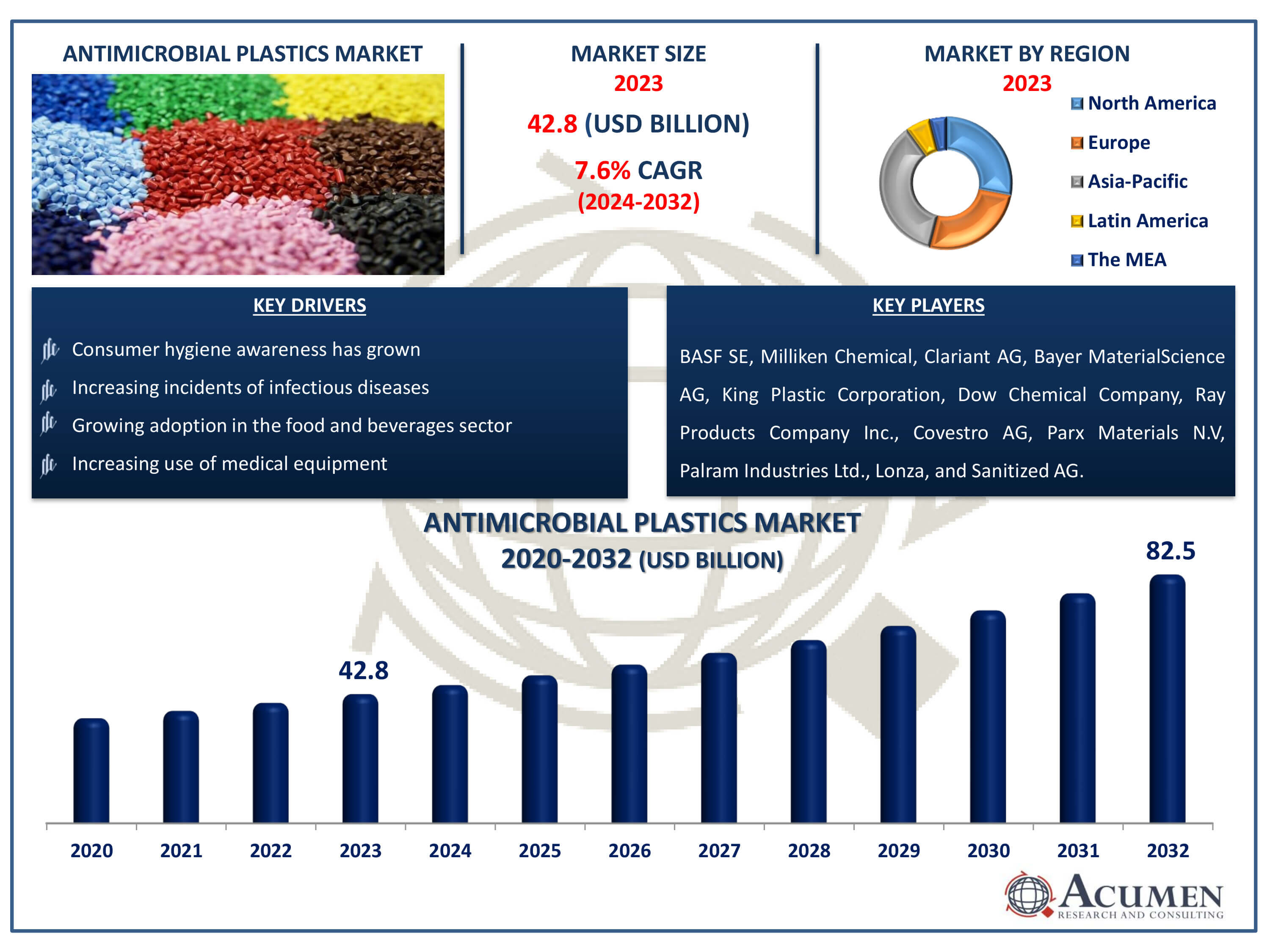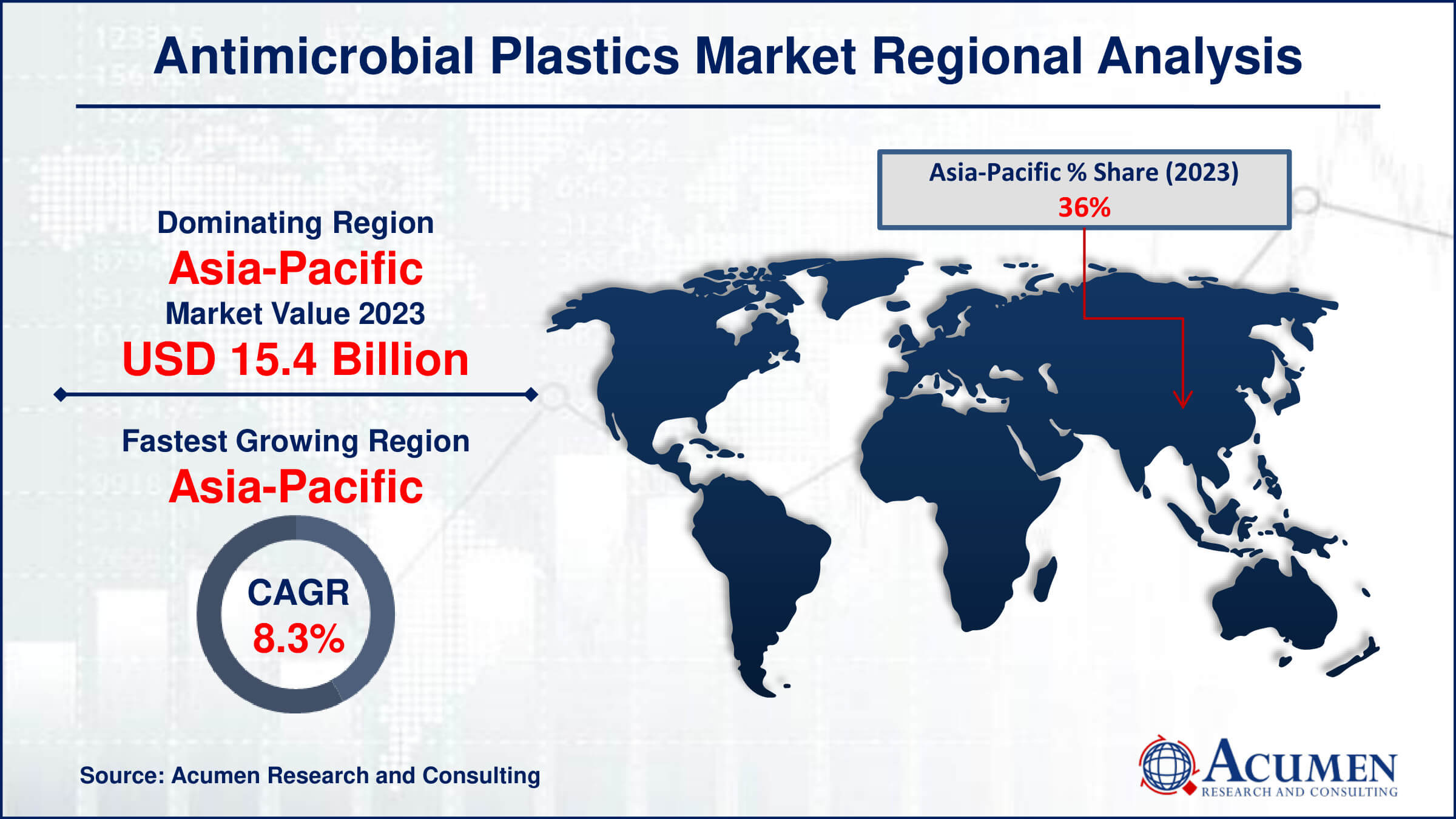August 2023
The Antimicrobial Plastics Market Size was USD 42.8 Billion in 2023 and is projected to reach USD 82.5 Billion by 2032, growing at a CAGR of 7.6% from 2024 to 2032.
The Antimicrobial Plastics Market Size accounted for USD 42.8 Billion in 2023 and is estimated to achieve a market size of USD 82.5 Billion by 2032 growing at a CAGR of 7.6% from 2024 to 2032.
Antimicrobial Plastics Market Highlights

Antimicrobial plastics are synthetic substances infused with active agents that inhibit germ growth, primarily on protective surfaces, thus promoting a hygienic environment. These compounds are known to extend the operational lifespan of plastics by reducing microbial contamination that can lead to premature degradation. Consequently, products made with antimicrobial plastics tend to be more durable and easier to recycle after use. As their use expands in manufacturing and consumer goods, the demand for antimicrobial plastics is expected to surge in the coming years. Moreover, they are gaining traction as substitutes for traditional materials in critical medical devices like ventilators and anesthetic equipment. This underscores their increasing importance in maintaining health and hygiene standards across various applications.
Global Antimicrobial Plastics Market Dynamics
Market Drivers
Market Restraints
Market Opportunities
Antimicrobial Plastics Market Report Coverage
| Market | Antimicrobial Plastics Market |
| Antimicrobial Plastics Market Size 2022 | USD 42.8 Billion |
| Antimicrobial Plastics Market Forecast 2032 | USD 82.5 Billion |
| Antimicrobial Plastics Market CAGR During 2023 - 2032 | 7.6% |
| Antimicrobial Plastics Market Analysis Period | 2020 - 2032 |
| Antimicrobial Plastics Market Base Year |
2022 |
| Antimicrobial Plastics Market Forecast Data | 2023 - 2032 |
| Segments Covered | By Additive, By Product, By End-Use, And By Geography |
| Regional Scope | North America, Europe, Asia Pacific, Latin America, and Middle East & Africa |
| Key Companies Profiled | BASF SE, Milliken Chemical, Clariant AG, Bayer MaterialScience AG, King Plastic Corporation, Dow Chemical Company, Ray Products Company Inc., Covestro AG, Parx Materials N.V, Palram Industries Ltd., Lonza, and Sanitized AG. |
| Report Coverage |
Market Trends, Drivers, Restraints, Competitive Analysis, Player Profiling, Covid-19 Analysis, Regulation Analysis |
Antimicrobial Plastics Market Insights
The adoption of antimicrobial polymers across various industries, driven by their superior properties and increasing demand, is expanding the antimicrobial plastic market significantly. Key drivers include their substitution of traditional materials in numerous applications and rising demand from sectors like medical and food and beverage industries. The COVID-19 pandemic heightened consumer awareness of hygiene, boosting the need for market in the antimicrobial plastics industry forecast period. In the food and beverage sector, the prevalence of chronic illnesses is prompting the uptake of antimicrobial polymers for packaging solutions. These plastics inhibit the growth of viruses and bacteria, enhancing food safety and shelf life.
Moreover, in healthcare, antimicrobial plastics are increasingly replacing conventional materials in the production of critical equipment such as anesthetic machines and ventilators. This shift is crucial in maintaining hygienic conditions and preventing healthcare-associated infections. Antimicrobial plastics offer strong moisture resistance and effectively inhibit the growth of germs, algae, and bacteria, making them pivotal in food safety protocols and various industrial applications. However, stringent environmental regulations and increasing concerns about pollution pose challenges to market growth. Manufacturers are therefore focusing on developing sustainable practices and materials to mitigate these impacts while meeting the growing demand for antimicrobial plastics across diverse sectors.
Antimicrobial Plastics Market Segmentation
The worldwide market for antimicrobial plastics is split based on additive, product, end-use, and geography.
Antimicrobial Plastic Market By Additives
According to antimicrobial plastics industry analysis, additives play a crucial role in imparting pathogen-inhibiting properties to antimicrobial plastics. These additives can be broadly categorized into organic and inorganic types. In the market, the inorganic category is anticipated to dominate due to its versatility and effectiveness against a broad spectrum of infections. Inorganic additives, such as silver and copper nanoparticles, possess natural antibacterial properties that are highly efficient against bacteria, viruses, and fungi. Their robustness and durability make them particularly suitable for applications requiring prolonged antimicrobial protection, such as medical equipment, food packaging, and hygiene products. As industries increasingly prioritize cleanliness and infection control, the demand for inorganic antimicrobial additives is expected to escalate. This solidifies their role as the cornerstone of the antimicrobial plastics market, driving innovation and adoption across various sectors.
Antimicrobial Plastic Market By Products
The commodity plastic segment emerged as the dominant force in the antimicrobial plastics market in 2023, commanding a significant market share. These versatile plastics find extensive application across various sectors, including textiles, packaging, hygiene products, and more, owing to their exceptional properties such as high impact strength, chemical resistance, and moisture tolerance. Notably, polyethylene and polypropylene antimicrobial polymers play a pivotal role in driving the demand for commodity plastics due to their wide-ranging applications and biocompatibility. The burgeoning demand from industries like processing, electronics, and medical products further propels the growth of this segment. However, concerns regarding plastic waste and increasing governmental regulations pertaining to plastic packaging usage pose challenges to the future growth trajectory of commodity plastics.
Antimicrobial Plastic Market By End-Uses
The healthcare segment is poised to play a pivotal role in the antimicrobial plastics market forecast period, solidifying its position as a significant consumer of antimicrobial plastics. A myriad of industries are swiftly integrating antimicrobial plastics into their operations, spurred by a complex and dynamic evolution marked by stringent standards, heightened consumer demand, regulatory constraints, innovative additives, and a broadening array of everyday applications. Across diverse industrial sectors, the quest for effective materials that cater to specific needs such as reliability, aesthetics, and odor reduction is driving the adoption of antimicrobial plastics.
Primary drivers of global demand for medical equipment include the escalating incidence of chronic and infectious diseases, a burgeoning population, and a surge in hospital admissions. Moreover, the growing preference for home-based treatment is fueling the consumption of various intensive care medical equipment, thereby reshaping the landscape of antimicrobial plastics in the healthcare sector. This shift towards home-based care is anticipated to drive demand for antimicrobial plastics, particularly in the healthcare sector, where they offer cost-effective solutions compared to traditional hospital settings.
Antimicrobial Plastics Market Regional Outlook
North America
Europe
Asia-Pacific
Latin America
The Middle East & Africa

Antimicrobial Plastics Market Regional Analysis
In terms of antimicrobial plastics market analysis, in 2023, the Asia-Pacific region has emerged as the leader in the antimicrobial plastics market, commanding the largest market share. This dominance is expected to strengthen further, driven by significant growth in key industries such as consumer hygiene, healthcare, and automotive sectors. Countries like India, Japan, Korea, and Thailand are making substantial investments to enhance healthcare infrastructure, responding to the challenges posed by an aging population and rising medical expenses.
The region's demand for antimicrobial polymers has been further propelled by outbreaks of communicable diseases such as Bird Flu and COVID-19, particularly in healthcare and food and beverage sectors. This has led to increased use of antimicrobial polymers in food packaging, meeting the growing demand for packaged food due to population growth and evolving consumption patterns in the region. Overall, the Asia-Pacific region is poised for robust growth in the antimicrobial plastics industry, driven by these diverse factors and trends during the forecast period.
Antimicrobial Plastics Market Players
Some of the top antimicrobial plastics companies offered in our report includes BASF SE, Milliken Chemical, Clariant AG, Bayer MaterialScience AG, King Plastic Corporation, Dow Chemical Company, Ray Products Company Inc., Covestro AG, Parx Materials N.V, Palram Industries Ltd., Lonza, and Sanitized AG.
Looking for discounts, bulk pricing, or custom solutions? Contact us today at sales@acumenresearchandconsulting.com
August 2023
October 2022
August 2018
February 2024